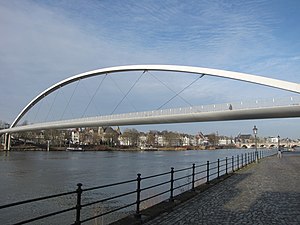Hoge Brug (Maastricht)
Coordinates: 50 ° 50 ′ 46 ″ N , 5 ° 41 ′ 50 ″ E
| Hoge Brug | ||
|---|---|---|
| use | Walk and bike path | |
| Crossing of | Meuse | |
| Subjugated | Maasboulevard | |
| place | Maastricht | |
| construction | Tied arch bridge | |
| overall length | 261 m | |
| width | 7.2 m | |
| Longest span | 164 m | |
| start of building | 2002 | |
| completion | 2003 | |
| planner | Greisch Bureau | |
| location | ||
|
|
||
The Hoge Brug ( High Bridge ) is a pedestrian and cyclist bridge over the Maas in the Dutch city of Maastricht . It connects the Centrum district (old town) with the Plein 1992 and the Céramique district , which was created on the site of the earlier ceramic works. It stands between the Saint Servatius Bridge (Sint Servaasbrug), the oldest bridge in the Netherlands, and the Kennedy Bridge.
The 261 m long and 7.2 m wide bridge crosses the Meuse and the Maas boulevard that runs along the left bank at a height of over 10 m in order to leave enough space for shipping. It is connected to street level by long stairs. The stairs have gutters on both sides for the bicycles. There are glass elevators on both banks, but they are not, as usual, next to the bridge, but penetrate the bridge deck in the middle.
The tied arch bridge has a large, centrally arranged steel arch with a hollow cross-section and a span of 164 m so that its pillars stand outside the water on the bank. The carriageway girder is a steel box girder that is slightly arched upwards and has a rounded, completely smooth underside. The 14 hangers consist of 50 mm thick wire ropes .
The Hoge Brug was designed by Bureau Greisch and carried out between 2002 and 2003.
Web links
Individual evidence
- ↑ a b Hoge brug footbridge in Maastricht on greisch.com
- ↑ Hoge Brug te Maastricht on vaarweginformatie.nl the Rijkswaterstaat


